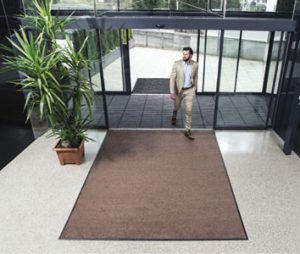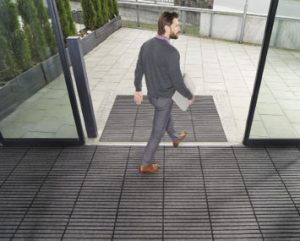 Lee Fox, Sales and Marketing Director for Kleen-Tex UK, discusses the key compliance areas facilities managers should be aware of when choosing, installing and maintaining floor matting systems
Lee Fox, Sales and Marketing Director for Kleen-Tex UK, discusses the key compliance areas facilities managers should be aware of when choosing, installing and maintaining floor matting systems
As many businesses prepare to reopen their premises to employees, customers and visitors, ensuring the highest levels of hygiene and cleanliness to mitigate the spread of bacteria and protect the health and safety of all individuals, has never been higher on the agenda.
Initially, floor matting may not seem an importance consideration in relation to this area. However, as a significant proportion of dirt found within a building is transported via people’s shoes, wheelchairs and pushchairs, the correct application of floor matting can successfully minimise the frequency and transfer of dirt within a building to subsequently improve overall hygiene levels.
However, in order to successfully achieve this, a more holistic view of floor matting is required throughout the industry to first understand the practical benefits that various systems provide for different areas of a building.
While specifiers and architects may initially outline a suggested floor type and size, particularly for the entrance of a building, this doesn’t mean that the solution is fit for purpose and can actually meet the unique demands of its specific application.
Here it becomes the responsibility of the facilities management team to ensure the ongoing suitability of the floor matting systems to successfully ensure all possible dirt and moisture is successfully captured and retained.
BRITISH STANDARDS
 For entrance areas in particular, facilities managers should first refer to the guidance outlined within BS 7953:1999, which shares information on the selection, installation and maintenance of matting systems to minimise the transfer of soil into a building and reduce its movement from one area to another.
For entrance areas in particular, facilities managers should first refer to the guidance outlined within BS 7953:1999, which shares information on the selection, installation and maintenance of matting systems to minimise the transfer of soil into a building and reduce its movement from one area to another.
Here it states that entrance floor matting must also reduce the risk of slip injuries, prolong the life of the interior floor finish and reduce the cost of ongoing maintenance.
It is therefore recommended that entrance mats should be more than 1.2 metres in length, so that individuals make contact with both feet when entering the building to remove the highest possible levels of dirt and moisture. For wheelchair traffic, the dimensions of the matting should be large enough for the wheels to turn twice before making contact with the flooring installed underneath.
INCLUSIVE DESIGN
Facilities managers should also refer to the Disability Discrimination Act (DDA) and BS 8300: 2009+A1:2010, to ensure that all floor matting located throughout a building is suitable for wheelchair users and disabled individuals. This includes having a slip-resistant surface and firm top layer to ensure the wheelchair can manoeuvre safely and securely across the mat’s surface. The shading and finish of the mat should also be considered to clearly highlight slopes or areas where the level of the floor may change.
Textile floor covering mats should also be either set flush with the remainder of the floor, or if surface laid, should be designed and constructed to maintain original dimensions and positions, to avoid slipping and prevent a tripping hazard.
FLOOR MATTING
 Whilst entrance matting may be the primary focus for facilities managers, it is a common misconception that floor matting is not required throughout other areas of a building. This is due to the fact there can be multiple significant transfer zones, which are prime areas for the transfer of dirt and moisture.
Whilst entrance matting may be the primary focus for facilities managers, it is a common misconception that floor matting is not required throughout other areas of a building. This is due to the fact there can be multiple significant transfer zones, which are prime areas for the transfer of dirt and moisture.
To fulfil duty of care and go above and beyond best practice, various floor matting solutions should also be installed throughout additional areas of a building. However, to ensure each of these mats are fit for purpose and fulfil their functional requirements, a matting survey should first be carried out to identify where potential transfer areas are throughout a building.
Conducting a survey will also enable the identification of floor mats for additional considerations, such as floor mats that are printed with safety messages in luminous ink to highlight fire exits in the event of a power failure, or display key safety messages for transit zones, which is particularly important for the warehousing and manufacturing sectors.
If left, dirt and moisture combine together and turn into dust, which is then easily circulated throughout an entire building and can have negative health effects for the buildings’ inhabitants.
In response to the current climate, improving air quality and minimising dust transfer is more important than ever, so reducing the level of dirt and moisture that is able to enter a building should be the first priority. This will also actively support a reduction in cleaning and maintenance costs, as the level of dust produced is significantly reduced.
Ongoing and sufficient maintenance of the floor mats is also integral to ensuring continued compliance as the mat must provide the same high levels of quality and safety as when it was first installed. This includes incorporating the floor mats into existing routines so that it becomes part of regular cleaning practices.
 By inspecting, laundering and quality control checking every floor matting system on a regular basis, facilities managers can ensure that the mats are maintained to an optimum level to ensure their continued capture of dirt and moisture, without presenting a potential slip or trip hazard.
By inspecting, laundering and quality control checking every floor matting system on a regular basis, facilities managers can ensure that the mats are maintained to an optimum level to ensure their continued capture of dirt and moisture, without presenting a potential slip or trip hazard.




